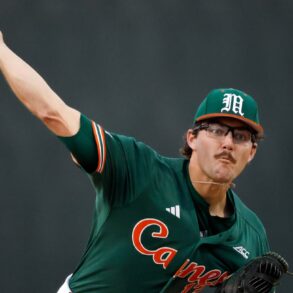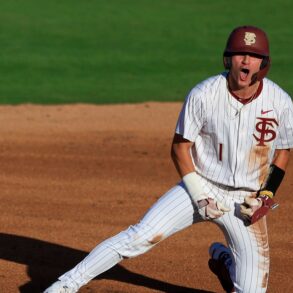
Image credit:
Riley Eikhoff (Photo by John Byrum/Icon Sportswire via Getty Images)
The 2025 NCAA baseball tournament is set to get underway on Friday, May 30, with teams opening regional play across the nation.
To get ready, Baseball America presents the ultimate tournament guide with stat-focused break downs of all 64 teams. Check out the full list of regional previews here.
1. Coastal Carolina
Coastal Carolina has the look of a contender when the game slows down. Its staff ranks top 20 nationally in strikeout (24.7%) and walk rates (8.3%), and it checks in at No. 2 in runs allowed per game (3.6). The trio of Jacob Morrison, Cameron Flukey and Riley Eikhoff gives the Chanticleers a deep and versatile rotation, each capable of working into the middle innings with low walk totals and bat-missing stuff.
Out of the bullpen, Ryan Lynch and Dominick Carbone headline a group that piles on pressure with strike-throwing and deception. The highest ERA belonging to a Coastal Carolina pitcher who has thrown at least 20 innings this year is 3.51.
Offensively, though, it’s a different story. Coastal’s .288 batting average, .442 slugging percentage, and 109 wRC+ are all modest marks relative to the hosting field. The Chanticleers rank outside the top 80 in runs per game, home runs and slugging, and often rely on timely hits rather than overwhelming pressure.
When they can dictate tempo and control the run environment, they’re dangerous. But if the game opens up, the offense hasn’t consistently shown the gear to trade punches.
2. Florida
Florida’s numbers are somewhat deceiving in that the Gators performed like two completely different teams in the first and second halves of conference play after opening with a program-worst 1-11 record in SEC games and closing out the year 14-4.
The Gators are a powerful bunch and rank No. 31 in home runs this year with Bobby Boser (.330/.431/.598 with 16 home runs, 12 doubles and 61 RBIs) and Brody Donay (.315/.430/.668 with 17 home runs 10 doubles and 38 RBIs) leading the way. The Gators still strike out at an exceptionally high 20.8% clip but that hasn’t stopped them from ranking 66th nationally in on-base percentage and 45th in wRC+.
While Florida’s offense has steadied after a slow start, its pitching has taken off. The unit’s lowly start to the season has since morphed into the No. 6 strikeout rate in the country as well as a the No. 55 ERA and No. 26 FIP. Liam Peterson (4.04 ERA with 93 strikeouts to 28 walks in 64.2 innings) and Aidan King (3.11 ERA with 60 strikeouts to 20 walks in 55 innings) have anchored their rotation, while Jake Clemente (1.99 ERA with 48 strikeouts to 17 walks in 31.2 innings) has been a revelation on the back end.
If Florida can play the way it has for the last several weeks, it has Omaha potential yet again.
3. East Carolina
East Carolina is built around its arms—and it has to be. The Pirates rank outside the top 80 nationally in home runs, on-base percentage, slugging percentage and wRC+, with a run-scoring average (6.3 per game) that sits 205th in the country. The offense is contact-driven, but its lack of on-base strength and power makes it difficult to string together crooked innings or play catch-up against premium pitching.
That puts immense pressure on a pitching staff that has remarkably held up well. East Carolina’s 4.35 ERA and 1.41 WHIP are both top 50 nationally, and it ranks 35th in strikeout rate at 23.3%, thanks in large part to lefty Ethan Norby who has 93 strikeouts over 72 innings but performed rather poorly in recent weeks, causing his ERA to climb to 4.12.
The Pirates must play to control tempo, suppress big innings and hope for timely execution at the plate. That formula has worked for East Carolina this year for the most part, but whether it travels in a regional setting is the looming question.
4. Fairfield
Fairfield brings a compelling case as a No. 4 seed with an analytically intriguing profile. Offensively, the Stags rank 31st nationally in runs per game (8.3) despite middling home run and slugging totals, a testament to their elite plate discipline and on-base skills. Fairfield walks at a 14.7% clip—ninth-best in the country—and owns a .412 on-base percentage that ranks 37th. Their strikeout rate (16.6%) is also among the nation’s lowest, suggesting a gap-heavy approach that keeps pressure on opposing defenses.
On the mound, the picture is less dominant but still steady. The staff’s 4.84 ERA and 1.44 WHIP rank well, and its strikeout-minus-walk rate of 8.0% ranks 140th, indicating pitch-to-contact tendencies rather than overpowering stuff.
Still, Fairfield keeps traffic manageable and has shown enough consistency to hang around in games. In a regional with top-end talent, Fairfield’s offensive identity could make it a nuisance.
This post was originally published on this site be sure to check out more of their content.




